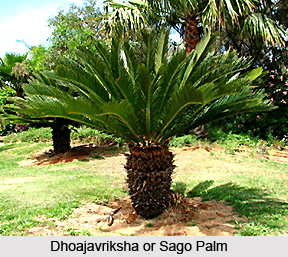 Dhoajavriksha is commonly known as Indian Sago-Palm, found across the nation. This medicinal plant is known as Golsago in Bengali, Indian Sago-Palm, Jaggery-Palm, Kitul-Palm, Toddy-Palm in English; Shankarjata and Shivajata in Gujarati. The plant is also known as Bagani and Baini in Kannada, Birla-Madd and Birlimad in Kongkan; and Anapana, Chundappana, Iram-Pana, Iram-Panei, Kala-Pana and Kondappana in Malayalam. In Oriya, this plant is known as Modhura, Solopa And Solopo; Dhoajavriksha, Dirgha, Mada and Meda in Sanskrit; while Irambanai, Kondalpanai, Kondapanei, Kon-Dapanna, Tippili and Tippilipanei in Tamil; Jilugu, Jilugujattu, Kondajivalaggu, Mari and Mhar in Sanskrit.
Dhoajavriksha is commonly known as Indian Sago-Palm, found across the nation. This medicinal plant is known as Golsago in Bengali, Indian Sago-Palm, Jaggery-Palm, Kitul-Palm, Toddy-Palm in English; Shankarjata and Shivajata in Gujarati. The plant is also known as Bagani and Baini in Kannada, Birla-Madd and Birlimad in Kongkan; and Anapana, Chundappana, Iram-Pana, Iram-Panei, Kala-Pana and Kondappana in Malayalam. In Oriya, this plant is known as Modhura, Solopa And Solopo; Dhoajavriksha, Dirgha, Mada and Meda in Sanskrit; while Irambanai, Kondalpanai, Kondapanei, Kon-Dapanna, Tippili and Tippilipanei in Tamil; Jilugu, Jilugujattu, Kondajivalaggu, Mari and Mhar in Sanskrit.
Dhoajavriksha or Jaggery Palm is considered to be indigenous to India and is very common in the moist forests of the Eastern and Western Ghats of peninsular India, especially in Kerala, cooler valleys of Chota Nagpur, Orissa, West Bengal and in the sub-Himalayan hills of northeastern India to an elevation of about 750 m, occasionally to 2000 m. Dhoajavriksha is cultivated in many parts of India for sago that is prepared from the starch harvested from the shaft or toddy (palm wine) and jaggery (palm gur), from the sap which is extracted from the spathe; and a versatile fibre is thud obtained from the leaf sheaths, petioles and floral stalks. Dhoajavriksha is also planted in gardens all across the country.
Dhoajavriksha is a lofty, handsome palm grows up to a height of 22 m with a smooth, grey, cylindrical trunk, and a crown of 6-10 large leaves. The leaves of Dhoajavriksha are bipin-nate and grows up to 6 m long and 4 m wide, primary divisions up to 1.8 m long, pinnae borne on 18-25 secondary rachises, each bearing 36 pairs of leaflets and a terminal leaflet. The petioles of Dhoajavriksha are very stout, 30 cm long and 4 cm wide. The spathe of Dhoajavriksha is boat-shaped that is 30-45 cm long and encloses inflorescence. The spadix is very long with up to 120 secondary branches on thick, cylindrical principal axils often hang down. The flowers of Dhoajavriksha are abundant and borne in groups of 3, both male and female blossoms in narrowly cylindrical pattern with light red. The fruit of Dhoajavriksha is double seeded and 1.7-2 cms in diameter. They are red when ripe with two seeds per fruit, with ridged surfaces. The fruits are essentially hairy.
The nuts or seed kernels of Dhoajavriksha are used as an external application for the treatment of hemicrania. In Ayurveda, Dhoajavriksha seeds are considered pungent and cooling, and are apparently used to ease thirst and fatigue. The freshly drawn sap from the spathe is widely used as a laxative. The fruits of Dhoajavriksha contain irritating, needle-like crystals and the pulp is internally very poisonous that can cause inflammation lasting for several hours.











